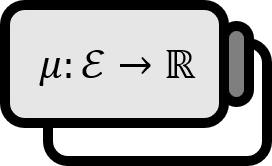Sigma Algebra and Measurable Spaces
Definition
For a set $X \ne \emptyset$, a $\mathcal{E} \subset \mathscr{P} (X)$ satisfying the following conditions is called a sigma algebra or sigma field on $X$. The ordered pair of the set $X$ and the sigma field $\mathcal{E}$, $(X , \mathcal{E})$, is called a measurable space.
- (i): $\emptyset \in \mathcal{E}$
- (ii): $E \in \mathcal{E} \implies E^{c} \in \mathcal{E}$
- (iii): $\displaystyle \left\{ E_{n} \right\}_{n \in \mathbb{N}} \subset \mathcal{E} \implies \bigcup_{n=1}^{\infty} E_{n} \in \mathcal{E}$
- (iv): $\displaystyle \left\{ E_{n} \right\}_{n \in \mathbb{N}} \subset \mathcal{E} \implies \bigcap_{n=1}^{\infty} E_{n} \in \mathcal{E}$
Explanation
If a sigma field $\mathcal{E}$ is given on a space $X$, then $(X , \mathcal{E})$ is called a measurable space. If a measure $\mu$ is given, then $(X , \mathcal{E} , \mu)$ is called a measure space, and in particular if the measure $\mu$ is a probability measure it is called a probability space.
Although the concept is the same, it is commonly called sigma algebra in mathematics and sigma field in statistics.
Carathéodory condition: If $E \subset \mathbb{R}$ satisfies $m^{ \ast }(A) = m^{ \ast } ( A \cap E ) + m^{ \ast } ( A \cap E^{c} )$ with respect to $A \subset \mathbb{R}$, then $E$ is called a measurable set and is denoted by $E \in \mathcal{M}$.
The term “measurable set” literally means a set whose length can be measured. By the countable subadditivity of the outer measure (see 외측도의 가산준가법성), $$m^{ \ast }(A) \le m^{ \ast } ( A \cap E ) + m^{ \ast } ( A \cap E^{c} )$$ is trivial, so verifying that a set is measurable is essentially the same as checking whether $$m^{ \ast }(A) \ge m^{ \ast } ( A \cap E ) + m^{ \ast } ( A \cap E^{c} )$$ holds.
Sigma algebra of measurable sets
Under the above definition, the collection of measurable sets of $X = \mathbb{R}$, denoted by $\mathcal{M}$, forms a sigma algebra with the following properties.
$\mathcal{M}$ is a sigma algebra with the properties below.
- [1]: $$ \emptyset \in \mathcal{M} $$
- [2]: $$ E \in \mathcal{M} \implies E^{c} \in \mathcal{M} $$
- [3]: $$ \left\{ E_{n} \right\}_{n \in \mathbb{N}} \subset \mathcal{M} \implies \bigcup_{n=1}^{\infty} E_{n} \in \mathcal{M} $$
- [4]: $$ \left\{ E_{n} \right\}_{n \in \mathbb{N}} \subset \mathcal{M} \implies \bigcap_{n=1}^{\infty} E_{n} \in \mathcal{M} $$
- [5]: $$ \mathcal{N} \subset \mathcal{M} $$
- [6]: $$ \mathcal{I} \subset \mathcal{M} $$
- [7]: If we denote $E_{i} , E_{j} \in \mathcal{M}$, then the following holds. $$ E_{i} \cap E_{j} = \emptyset , \forall i \ne j \implies m^{ \ast } \left( \bigcup_{n=1}^{\infty} E_{n} \right) = \sum_{n = 1} ^{\infty} m^{ \ast } ( E_{n}) $$
- $\mathcal{I}$ is the collection of all intervals, and $\mathcal{N}$ is the collection containing the empty set.
Note that item [7] is essential for the generalization of length that Lebesgue envisioned.
